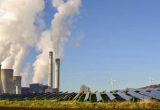Ways of a new water policy 4/4
A vision for the future: if the Bundestag, i.e. German Parliament, passes a water conservation law that requires builders to install efficient fixtures, promotes private retrofits such as water-saving showers, toilets, washing machines and dishwashers and demands a water penny from large consumers, we will soon consume only half as much water as we do today.
Every year 25,000 liters of water per capita would thus be saved, i.e. 250,000 liters in ten years. A family of four would save a million liters of water without sacrificing any comfort.
WATER 2015
Industry will – determined by political regulations – learn to recycle water. Used water can be reused ten times and more. We need water circuits, as the Deutsche Bahn shows us for toilet flushing in its high-speed trains ICE 3. Agriculture could reduce water consumption by two-thirds using underground irrigation, industry by as much as 90 percent.
In ten years chemical factories will only use substances which they can decompose in their sewage treatment plants. Chlorine is forbidden in our model for the future. Using circulatory systems we could reduce water consumption for the production of a kilogram of paper to one tenth, compared to today. The cooling water of power plants must no longer contain any heavy metals. Decentralized and renewable energy will render water-absorbing power plants redundant.
WATER 2030
Farmers use liquid manure or stable manure as fertilizer. If liquid manure is not sprayed any more as in former times, but is introduced directly into the soil through thin tubes, the wind can no longer carry the toxic ammonia to the sea and forests. Nitrate cannot reach the soil and groundwater any more, if the fertilizer is sparingly dosed. Incidentally, in 25 years fertilizers will no longer be provided by chemical companies but by the farmers’ cows.
The chemical industry today produces 116,000 different chemicals whose long-term effects on water and soil are still largely unknown. A water conservation policy will ensure that by 2030 the only substances that may be produced are biodegradable or can be re-integrated into production. The water circuit must close.
Should this water conservation policy be implemented consistently, the water revolution will be completed by 2030.
We have all the technological means for this vision. What is missing, however, is a new water awareness among consumers and a new water policy “from above”. Municipal utilities in Munich have proven that it works and how. Only 15 years ago, half of Munich’s drinking water had to be pumped up from a depth where water flows very slowly and can therefore repurify itself just every 10,000 years.
Chemicals used in industrial farming were responsible for highly contaminated surface water. Municipal utilities have offered many farmers around Munich financial incentives if they switch to organic farming.
Now mainly organic farmers operate here without using fertilizers. The quality of drinking water has substantially improved. And, on top of it, the municipal utilities, which were rightly awarded the water prize of the Hundertwasser Foundation, also save money, because chemical cleaning of Munich’s drinking water was more expensive than the financial assistance for organic farmers.
That means economizing, protecting and repairing.
Water protection area or water pollution area?
Reconsidering the patterns of nature would assist us greatly. Where once natural landscapes were found with functioning water systems, a high degree of aesthetics and harmony was most likely palpable. Many cities owe the quality and originality of their appearance to water: Venice, Amsterdam, Bergen, Freiburg, Rio de Janeiro, San Francisco, Chicago, Detroit, Aachen, Friedrichshafen, Konstanz, Hamburg and Baden-Baden – for instance.
Water exerts a strong influence on the urban climate and thus on the psyche of its residents. Architects will again learn to understand that rainwater run-off does not have to be hidden. Its flow and its sparkle can be conceived as a natural piece of art. Ripples and reflections of light allow city-dwellers an emotional and conscious relationship to the natural element water.
Public squares, parks and gardens in our future cityscapes should again be enriched by aquatic pieces of art; open channels that are operated with rainwater or are even part of the wastewater system can – as it has been the case in Freiburg for quite some time now – contribute to traffic calming.
A responsible water policy must be designed so that some day we can say to our children with a clear conscience: Children, this is your water! You can again bathe and swim in the rivers. Many fish are back in the rivers. And they are not sick any more. For we have meanwhile learnt that what makes the fish sick, will also make people sick.
We should enter into a symbolic water-generational contract with our kids. We have not inherited water from our parents – we have borrowed it from our children.
All people of all generations should be made aware: Water is happiness, water is wealth. Yet it is also freedom, justice and security.
“If the river dies, the people will die“ as a Brazilian saying goes. But the same applies to: As long as the river lives, the people live. We have the choice.
Part 1: Water is becoming more precious than gold 1/4
Part 2: So water is more than H2O 2/4
Part 3: Water in trouble 3/4
Part 4: Ways of a new water policy 4/4
Source
Franz Alt 2013 | Translation: Peter Reif 2013








